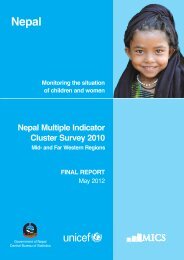Executive Summary of Nepal Labor Force Survey – 2008 (II)
Executive Summary of Nepal Labor Force Survey – 2008 (II)
Executive Summary of Nepal Labor Force Survey – 2008 (II)
Create successful ePaper yourself
Turn your PDF publications into a flip-book with our unique Google optimized e-Paper software.
population aged 5 years and above was in the<br />
Dry season, the <strong>2008</strong> survey found that the<br />
Dry season had the lowest estimate <strong>of</strong><br />
economically active population and the peak<br />
season was the Rainy season. The Labour<br />
<strong>Force</strong> Participation Rates for 5 years and<br />
above reflect the same situation. However<br />
when one considers the LFPRs for those aged<br />
15 years and above, the 1998/99 survey peak<br />
was in the Dry season, indicating that<br />
significantly fewer children were economically<br />
active in the Dry season, and for the <strong>2008</strong><br />
survey the peak continued to be in the Rainy<br />
season. Current unemployment rates for those<br />
aged 5 years and above were highest in the<br />
Rainy season in 1998/99 but highest in the<br />
Winter season in <strong>2008</strong>. The number <strong>of</strong><br />
employed with agricultural occupations was at<br />
its highest in the Winter season in 1998/99 but<br />
highest in the Rainy season in <strong>2008</strong>. The<br />
aggregate number <strong>of</strong> hours worked was also<br />
highest in the Rainy season in 1998/99 but<br />
relatively stable over the Rainy and Winter<br />
seasons and lowest in the Dry season in <strong>2008</strong>.<br />
MIGRATION AND ABSENTEES<br />
Migrants<br />
The NLFS <strong>II</strong> estimated that about 33 percent<br />
<strong>of</strong> the enumerated populated (all ages) had<br />
migrated to their current location either from<br />
another VDC or municipality in <strong>Nepal</strong> or from<br />
outside the country.<br />
The rate <strong>of</strong> lifetime migration (all ages) was<br />
higher for females (44 percent overall, with 88<br />
percent <strong>of</strong> female migrants from within <strong>Nepal</strong><br />
and 12 percent from outside <strong>Nepal</strong>) compared<br />
with males (21 percent overall, with 85 percent<br />
<strong>of</strong> male migrants from within <strong>Nepal</strong> and 15<br />
percent from outside <strong>Nepal</strong>).<br />
Most movement was from rural areas <strong>of</strong> <strong>Nepal</strong><br />
(80 percent <strong>of</strong> the migrants) with only 7<br />
percent <strong>of</strong> migrants coming from urban areas<br />
and 13 percent from abroad. For lifetime<br />
migrants now in urban areas 77 percent had<br />
moved from rural areas, 13 percent had<br />
moved from other urban areas and 11 percent<br />
had arrived from outside <strong>Nepal</strong>.<br />
Migration arises from a combination <strong>of</strong> many<br />
reasons. In NLFS <strong>II</strong>, most (48 percent) lifetime<br />
migrants, all ages, said that “marriage” was<br />
the main reason for their movement. Other<br />
reasons given were “other family reason” (30<br />
percent) and “easier life style” (8 percent).<br />
For the population aged 5 years and above,<br />
about 37 percent were found to have migrated.<br />
The rate <strong>of</strong> migration is higher for currently<br />
unemployed aged 5 years and above (56<br />
percent <strong>of</strong> the unemployed had migrated) than<br />
currently employed aged 5 years and above<br />
(42 percent) and currently inactive aged 5<br />
years and above (27 percent).<br />
Absentees<br />
Almost 15 percent <strong>of</strong> the total population<br />
(including absentees abroad) <strong>of</strong> all ages were<br />
found to be absent or away from home. More<br />
adults aged 15 years and above (23 percent <strong>of</strong><br />
the population including absentees abroad)<br />
are away from home as compared to that <strong>of</strong><br />
children aged under 15 years (6 percent <strong>of</strong> the<br />
population). Out <strong>of</strong> total absentees aged 5<br />
years and above, 21 percent are currently<br />
studying and 51 percent are working.<br />
Nearly 44 percent <strong>of</strong> households have at least<br />
one absentee currently living either abroad or<br />
within the country. When differentiating<br />
between abroad and within the country, it<br />
shows that slightly more than 29 percent <strong>of</strong><br />
households have at least one absentee<br />
currently living abroad. Whereas, slightly more<br />
than 19 percent <strong>of</strong> households have at least<br />
one absentee currently living within the<br />
country.<br />
REMITTANCES<br />
The proportion <strong>of</strong> households receiving a<br />
remittance (from either an absentee or from<br />
another person) was 30 percent <strong>of</strong> all<br />
enumerated households. The average<br />
Pre Liminary<br />
v
















